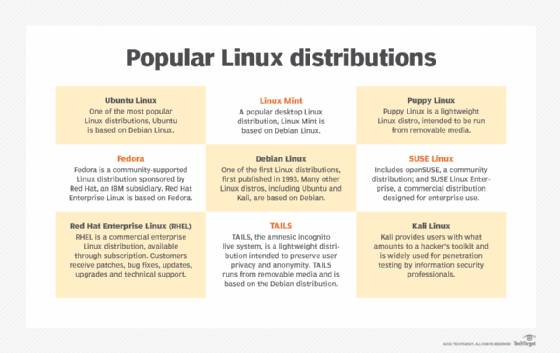Red Hat Enterprise Linux (RHEL)
What is Red Hat Enterprise Linux (RHEL)?
Red Hat Enterprise Linux (RHEL) is an enterprise Linux operating system (OS) developed by Red Hat for the business market. RHEL, formerly known as Red Hat Linux Advanced Server, is certified with thousands of vendors and across hundreds of clouds.
RHEL provides users with a reliable, consistent foundation across environments. It is equipped with all the necessary tools to rapidly deliver application services and workloads. RHEL is based on a free, Open Source model like all Linux distributions.
In the past, RHEL was available at no cost, and users only had to pay for support. However, Red Hat has since created two versions of RHEL. One is a version with less frequent version releases. The other is Fedora, developed by the Fedora Project. It undergoes more frequent version releases and offers the latest available technologies.
A large community of developers actively contributes to Fedora. Red Hat takes features the Fedora Project develops and incorporates them into RHEL.
Although Red Hat makes its source code available for download, verbatim copying of the distribution is forbidden. However, users can view the source code and customize it as needed. The RHEL OS supports a range of workloads in physical, virtual and cloud environments. RHEL editions are available for servers, mainframe, SAP applications, desktops and OpenStack.
Examples of RHEL distributions
Standard RHEL distributions include applications, development tools, utilities and services, such as the following:
- Compiz
- Common Unix Printing System
- Dynamic Host Configuration Protocol
- Firefox
- GNU Image Manipulation Program
- MySQL
- Python
- Samba

Benefits of RHEL
RHEL is known to minimize deployment friction costs and accelerate the time to value of critical workloads. This approach helps development and operations teams seamlessly create and innovate across enterprise environments.
RHEL contains a Linux kernel and several applications that perform specific tasks. Some noteworthy Linux distros derived from RHEL include Oracle Linux, Pie Box Enterprise Linux, CentOS and Scientific Linux.
RHEL powers and supports several technologies. Among them are application development tools, automation protocols, cloud computing, containers, middleware, storage, microservices, virtualization and management software.
How RHEL is managed and used
Various tools are available to administer, control and manage RHEL. It can be deployed on physical systems on premises, in the cloud or as a guest on hypervisors. It helps orchestrate the hardware resources for a variety of basic computing requirements. It also supports all leading hardware platforms and many custom and commercial applications.
Red Hat Smart Management is an add-on that, together with Red Hat Satellite, enables seamless management across the lifecycle of RHEL systems. Smart Management supports deployment of unlimited guests in dense environments and on supported hypervisors, including Microsoft Hyper-V, Red Hat OpenShift Virtualization, Red Hat Virtualization and VMware.
RHEL Atomic Host is a RHEL 7 alternative that runs Linux containers. Developed to be lightweight and efficient, RHEL Atomic Host used in cloud environments as a runtime container system.
RHEL Workstation was developed for advanced users with more powerful hardware. It is optimized for high-performance animation, graphics and scientific applications.
RHEL Developer Suite is a self-supported distribution that is only for development purposes. RHEL Developer Suite also includes tools like Red Hat Developer Toolset, RHEL Add-Ons and Red Hat Software Collections development tools.
Find out what you need to know when switching from Windows to Linux.






